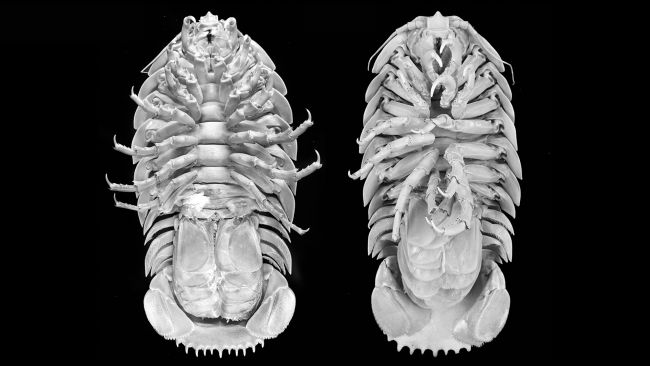How do you feel about bugs?
Are you the kind to run screaming from a room if you see a spider?
Or will you happily watch a centipede crawl across the floor?
Whatever the case, it's safe to say that the crawlers in question are pretty small. But what would you do if the bug was the size of this?
View this post on Instagram
Whoa! It's a pretty good bet that nearly all of us would be a bit freaked out if that critter skittered across our floor! But scary or not, this is not exactly a bug. It's an isopod.
Meet Bathynomus raksasa, a giant marine isopod also known as the 'Darth Vader' isopod. (It got the name for its body's similarity to the mask of the Star Wars villain.) The extremely excited guy in the Instagram post above is thrilled because it was recently caught for the very first time during an expedition in Indonesia. For these marine biologists, it was a big moment!
So to celebrate their success, we're going to look closer at what exactly it is. (Just not too close a look.)
Crustacean creatures
There are around 10,000 different species of isopod, including some that likely live in your home right now. Of course, those are the tiny wood lice that are often called pillbugs or potato bugs. These animals are around a centimetre long and honestly pretty adorable. See?

We tend to think of land, or terrestrial, isopods as bugs because they share a lot in common with insects and spiders. Similar sizes, shapes, colours. But they are in fact much more closely related to marine animals like crabs, shrimps, and lobsters. And once you get to these marine isopods— the ones that do live in the water—they tend to be a bit freakier.
Or a lot.
Giants and parasites
Many marine isopods are parasites—this means that they survive by living on and even feeding on a host animal. There are even species that eat the tongue of a fish, attach themselves to the same spot where that tongue once was, and then survive by eating the food that the fish tries to eat. (Don't worry, we're not attaching a photo of that guy!)
Anyway, despite his scary name, the 'Darth Vader' isopod is not a parasite. Or even a space tyrant.
But it is one of the biggest—and newest—isopods known to science. It measures about 33 cm (13 inches) long, which is about the size of a puppy. These creatures live on the ocean floor at incredible depths—around 1,200 metres (4,000 feet) down. There they feed expertly on dead animals that fall to the bottom. So not tongue-replacing gruesome, but still kind of unsettling.
Check out this Instagram gallery to see different angles of this deep sea Darth and some of its crustacean cousins.
View this post on Instagram
Of course, in the end, it is just another animal living on our unique planet. As marine scavengers, they perform a similar task to many other animals in helping to recycle dead organic matter. That's important stuff.
That said, will any of us ever be quite as excited as that gentleman was to hold one in our hands? Maybe we shouldn't knock it until we've tried it!
 The isopod Bathynomus raksasa was recently discovered in the Indian Ocean near Indonesia. (Sidabalok CM, Wong HP-S, Ng PKL (ZooKeys 2020))
The isopod Bathynomus raksasa was recently discovered in the Indian Ocean near Indonesia. (Sidabalok CM, Wong HP-S, Ng PKL (ZooKeys 2020))










I like potato bugs.
Creepy ❗
it is very cute.
I like cup cake bugs.
marshmallows bugs.
and marshmallows bugs.